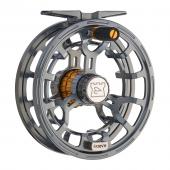Chasing the Cat
Catfishin' with a fly rod.
A little thumbing your nose at convention is good for the soul. Especially at times like this, when a nine-foot Heddon #35 bamboo fly rod made 85 years ago is used to fling a large weighted Woolly Bugger soaked in chicken-liver blood into the Musselshell River around Mosby. The casting motion is reminiscent of watching Sergeant Saunders toss a grenade at a German pillbox on the long-ago show Combat. Running with the past while fishing in the present creates a curious mindset that borders on dissociation—not an uncommon experience in my life.
The land rising above the river hints at the ancient power of the Missouri Breaks a few miles north. Late afternoon. Overcast. Temperature in the fifties. Kind of spring, but not the emerald, balmy version just yet. Dry and brown except for some dark green Ponderosa and cedar-like bushes that hang onto the sides of gullies where infrequent rain has exposed gray soil and bleached white fossils. Mule deer watch from the shade, and a turkey gobbles somewhere over a bluff. Magpies are arguing about something. The river is turbid. Make that muddy brown, actually, but the channel catfish have always been here, probably for eons.
Fly fishing is a passion, and while this method of taking fish will not sit well with the far-and-fine crowd, I don’t care. Hooking and then fighting a ten-pound fish on this stout bamboo rod is exhilarating. Only a few are caught, two or three, and they are kept for pan-frying in butter and peanut oil after being lightly dredged on a mixture of cornmeal, sea salt, and ground black pepper. Served with lemon wedges, they make a complete meal. As Buffett once wrote, “I treat my body like a temple. You treat yours like a tent.” In my case, an old, canvas tent.
The Heddon rod is too refined and delicate to be placed on a forked stick while I wait for the tip to bob and jerk, telling me it’s time to grab on and pull back to set the hook. Instead, I hold it and follow the Bugger with the tip as it tumbles along the bottom in its own dim world. When the downstream progress stops, the rod is lifted evenly towards the sky until I feel firm resistance. A couple of tugs quickly set the hook.
This happens within a minute of the first cast—the fish are always here. Immediately after the set, the cat runs downstream, going through 30 yards of fly line and into the backing. The equally venerable Meisselbach reel makes a ratcheting scream as the drag provides some checking to this full-tilt flight—but not much.
I used to fish with the modern graphite rods and shiny high-tech reels. Several years back, I realized that I missed the old stuff—the incredible craftsmanship of rod builders like Bernard Hills, Eustice Edwards, or Paul Young. There’s something about a century-old Hardy Perfect or this Meisselbach that appeals to my curmudgeonly “things were better way back when” nature. The almost-new Ugly Stik Muskie rods and equally unused reels are normally left home. I prefer the setup being used right now. When a fish reaches the end of the backing, which is rare, the rod is pointed downriver at the enraged catfish, and the leader is allowed to pop, sparing both the Heddon and the catfish.
In this instance, the fish tires as I pull it up through the water and drag it to shore, walking backwards up the bank. The cat flops in a desultory display of resignation. This one might weigh a dozen pounds. Close to half of that will be sliced into a pair of thick, light pink fillets. Perhaps only walleye tastes as good as channel catfish in the freshwater world, but that’s a personal preference. I set the rod down in a clump of dry grass and pull on leather gloves to the avoid the painful sting of the fish’s spine. Grabbing the animal by the tail, I haul it to a nearby cooler full of ice and lay it carefully on the cold crystals. Needle-nosed pliers remove the Bugger with a hard twist. The cooler lid clamps shut with a muffled “thump.”
I consider trying to catch one more.
Catfishin' Concerns
I prefer a fly rod for this benign madness, but a medium-heavy spinning or baitcasting setup is more practical—15-pound monofilament line, 1/4-oz. sinker, and chicken livers on a #4 or #6 treble hook. Bring gloves, a cooler and ice, headlamp, fillet knife, and pliers or a fisherman’s tool to complete the picture.
Catfish will eat almost anything; a consistent producer is a weighted #2 4x long Woolly Bugger in any color seasoned with essence of chicken livers and run through holes in a river. A small weight attached to a 0x leader at the head of the bugger is necessary to sink down to the streambed. Bait choice is personal, but experience has proven that chicken livers work best on rivers from the Powder, to the Missouri, to here. If catch-and-release catfishing is the plan, by all means do so. They’re a tough species and will survive your rude attentions. Again, this is a personal choice. With catfish, I eat what I catch and limit the number caught.
John Holt spends as much time fishing as is humanly possible.












